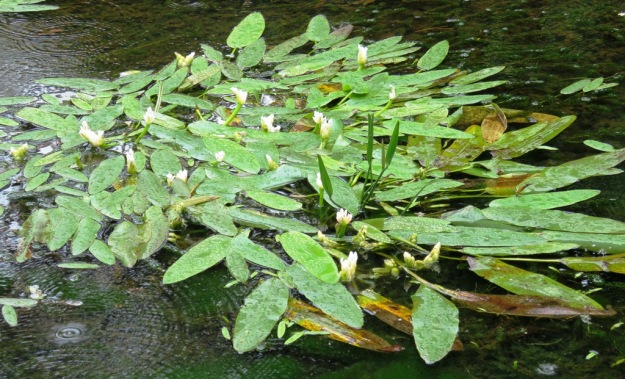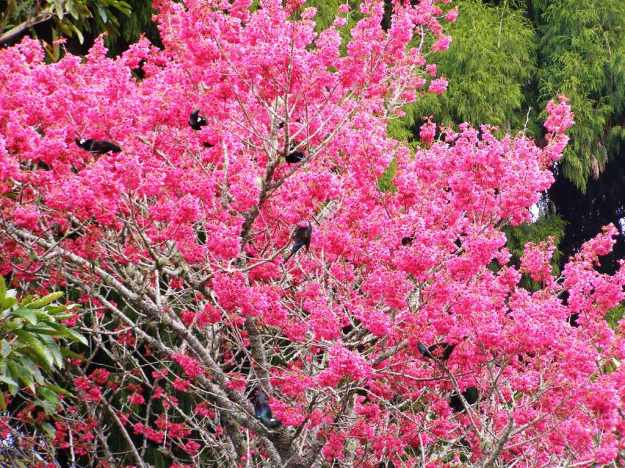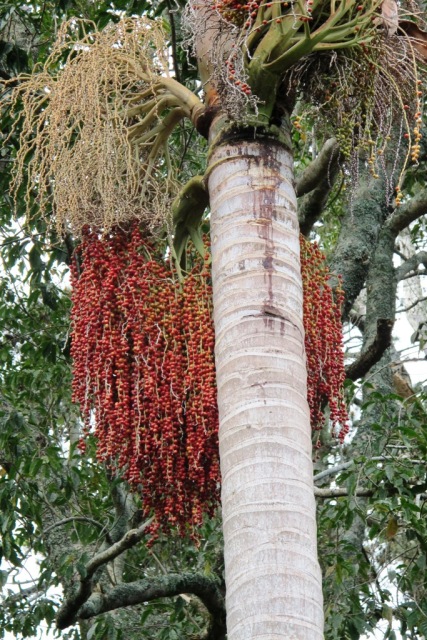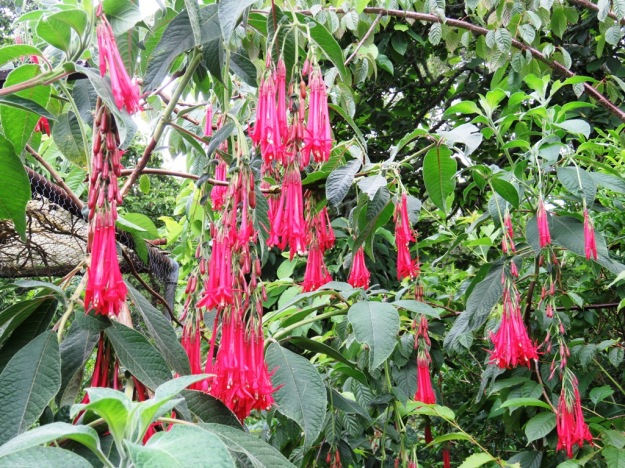After advocating for wildflowers on our road verges in January, it is perhaps ironic that I follow up with the worst weeds in our garden. All are ornamental garden escapes and none should be liberated to roadsides.

Cape Pond Weed
There are times Mark has wanted to line up and shoot the former neighbour upstream from us who deliberately planted Cape Pond Weed – also known as water hawthorn, botanically Aponogetum distachyum. Pretty it may be in bloom, but we have been waging war on it for well over a decade. Floods scoured it out upstream but it has made itself right at home in our slow moving sections. We spend countless hours raking it out each summer because it we don’t, it will only take one full season before it covers the entire water surface. Miss one piece and it grows away again at an alarming speed.

Prunus campanulata filled with tui
Prunus campanulata ranks amongst our two worst weeds. We are constantly pulling seedlings out, or digging if they have snuck through to a second season. Any older than that, and they require poisoning. Yes I know some folk think we should get rid of all of these but the tui! The tui! And please do not tell me to plant kowhai for the tui instead because they don’t flower at the same time and even our largest kowhai trees cannot sustain the scores of tui that frequent our early blooming Taiwanese cherries. So we continue to deal to the unwanted seedlings on an ongoing basis.
There is hope. Mark has been turning his attention to the sterile campanulatas we have here, because it is the seed that is the problem. His father bred sterile campanulata hybrids – ‘Pink Clouds’, ‘Mimosa’ and ‘Petite Pink’. The last variety is probably not commercially available now which is a pity because it is a true dwarf tree. The problem with all three varieties is that they are candy pink, not the sought after carmine red. But we have a few sterile reds with some possible options which give flower power and nectar for the tui without the curse of seed.

About the bangalow palm’s seeding ways…
The other shocker – maybe I had better whisper this, given its popularity – is the bangalow palm (Archontophoenix cunninghamiana). Yes it is handsome and reliable but this Aussie import is far too keen to make itself at home. It took a long time for our specimens to start flowering but boy, are they a problem now. Mark tries to cut the seed off as soon as it is visible, but this requires the extension ladder and a pole saw. There is probably not a square metre left in our garden where we have yet to find a germinating bangalow. What is particularly concerning is that in the early stages, they are very difficult to pick apart from seedling nikaus. If you are anywhere near native bush or reserve, this is one plant that you should question having in your garden. Based on our personal experience, we recommend the Queen Palm (Syagrus romanzoffiana) as an alternative.
Mark adds in Cornus capitata, the weedy dogwood. It was favoured by his father who planted it all along one of the road frontages and Mark has been battling it ever since. At least it makes good fire wood.

Fuchsia boliviana performs TOO enthusiastically in our climate
We have reviewed pretty Fuchsia boliviana. We acquired it before it appeared on the National Plant Pest Accord but never moved it into the garden. Thank goodness. In the wilds of the “plant out” area, where some specimens can languish for years while waiting for the right spot to be found, it grew far too vigorously and the carpet of seedlings rang loud alarm bells. It is another of those plants where a sterile form would be advantageous because it flowers for months on end, is showy and has attractive foliage.
Dare I mention the wonderfully fragrant Himalayan Daphne bholua? It is not in the same league as the previous plants but it has certainly seeded down all round the place here. Not all the seedlings flower, either, which is not to their credit. It is another example of a plant which is highly prized internationally but can become a significant weed in our benign climate.
It can be a mighty fine line between a desirable self-seeder and a weed. Most of the plants mentioned produce berry-like seeds which are then distributed by the birds, particularly the kereru. Plants which only seed down close to the parent are manageable but once our feathered friends are on the loose, it becomes a different matter altogether.
First published in the March issue of NZ Gardener and reprinted here with their permission.

Worst weed … Sounds: passion fruit vine and old man’s beard. Fighting it all the time to keep the native bush alive.
Worst weed … Geraldine: clover and dandelion.
Worst weed of all time: bag of stuff I got in ’86 from up north.